Even in California this is a lean time of year for fruit. But we get some different citrus here, which is keeping me going as I wait for early summer fruits to hit. Let me introduce you to some tiny and giant citrus family members you may not have tried before.
First the babies, tiny kumquats. Botanically known as citrus japonica, and native to Asia, kumquats look like mini oranges but are only about the size of a large olive.
What’s fascinating about kumquats is that you eat the whole thing, without peeling – pop one in your mouth like a grape. The small bit of juicy flesh inside is tart, but outer orange rind is very sweet. Weird and cool, kumquats are like orange zest with a squirt of pulp – nature’s marmalade in one cute little marble.
Bite in carefully, because they can have a seed or two, and when they do, it’s a full-sized orange seed, not a mini one.
I haven’t seen kumquats at the market this year, but these are from a friend’s tree. Citrus trees are so great to grow at home, as the fruit is naturally pest-resistant.
At the flip side of the size spectrum is the giant pomelo (pronounced POM-uh-low or PUM-uh-low), with the apt botanical name citrus maxima. Native to southeast Asia, pomelos range in color from green to yellow. Small pomelos are the size of a large orange, while the largest can be as big as a melon.
Pomelos are similar to grapefruits, but sweeter. It is easy to separate the large pulp from thick pith, and the flesh can be eaten out of the pith or removed for another use. With a light citrus flavor – not as sugary as orange flesh but without the bitterness of grapefruit – pomelo is a very versatile fruit that is refreshing for eating straight or in salads.
Prepping a pomelo feels funny – the thick white rind is soft and squishy. Cut off the ends, then score down the sides with a knife to make peeling easier.
Sometimes the fruit seems buried in the fluffy rind. Keep peeling.
When you break the peeled pomelo in half, you’ll see how easy it is to separate the thick pith from the flesh. Unlike the delicate flesh of oranges and grapefruits, sturdy pomelo flesh does not spontaneously burst into juice.
But when you bite into it, all the juice comes out, cool and sweet-tart. I love pomelo in spicy southeast Asian salads, with Thai basil, fresh mint and crushed peanuts. Though I admit I’ve never made one at home, because pomelos I buy always get eaten before I get around to cooking with them.
Pomelos are a grandaddy of the citrus family not just in size but in lineage. There’s a lot of cross-breeding among citrus families:
Pomelo + sweet orange = grapefruit (Odd to me since neither pomelos nor oranges have bitter flesh, but most grapefruits do)
Pomelo + tangerine = tangelo (large tangerines with a knobby end)
White grapefruit + pomelo = oroblanco grapefruit (a fantastic sweet, juicy grapefruit without bitterness; the ones I’ve had look and peel like a small pomelo)
Here’s a lineup: tangelo, ruby red grapefruit (ruby red is not a hybrid, just a mutation), and pomelo (citrus maxima indeed!).
Earlier this year I also bought an amazing grapefruit-orange hybrid at the Santa Monica Farmers Market, which looked like a regular white grapefruit but was extremely juicy with a fresh, sweet taste. I ate it out of hand in segments, like an orange, and wished I’d asked the vendor what it was called. If anyone finds out (from the organic citrus vendor at the Saturday market), I would love to know.

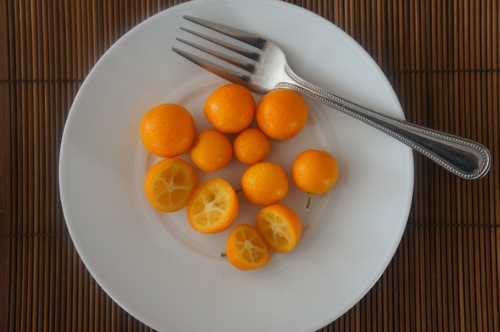
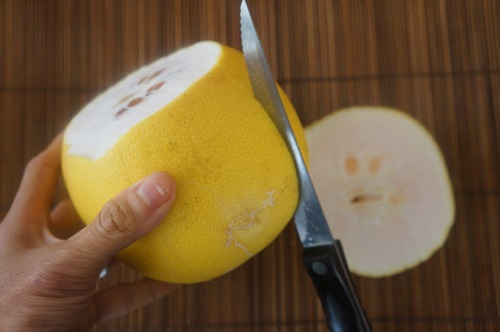

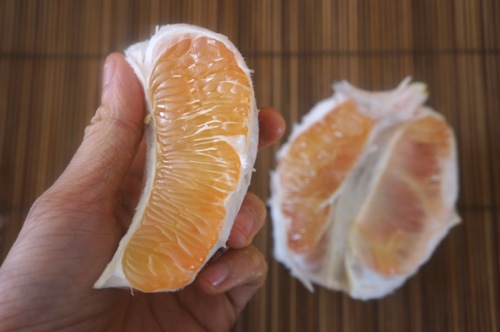
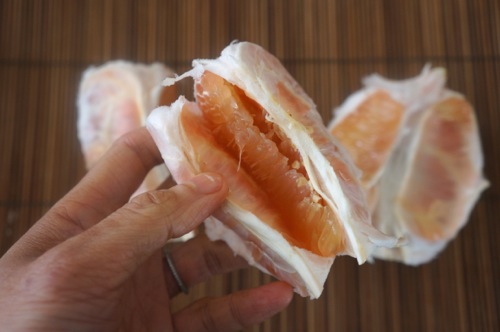
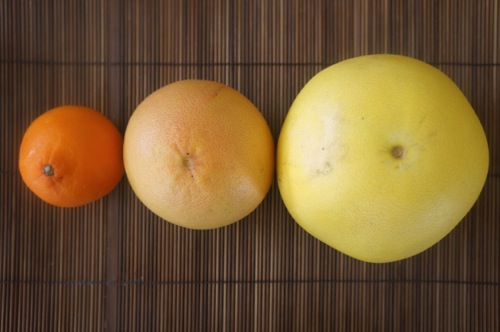




We’re so lucky to live in a part of the world where we can grow all these wonderful fruits as well as eat them. I am a big fan of kumquats; picking one and popping it into your mouth is such a delight!
hi debby – could not agree more! gardener’s paradise here…i appreciate it despite my black thumb. =P